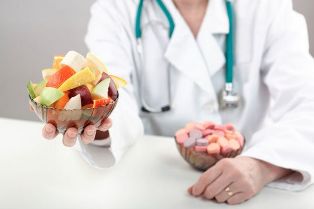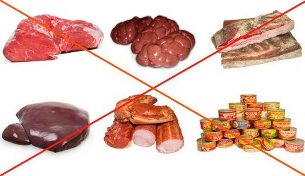A diet for gout is almost the first necessity, because this disease is associated with metabolic disorders. What foods can you eat if you have gout, which ones you don't, and which ones should be limited?

Gout is a disease caused by metabolic disorders. It occurs when urate crystals (uric acid salts) build up in the joints. These crystals begin to form when the level of uric acid in the blood is high and this, in turn, occurs when the body produces too much of this acid or the kidneys cannot handle it. In such cases, crystals, similar to sharp needles, begin to form in the joints and surrounding tissues. These needles cause pain, inflammation, swelling; in general, gout symptoms. Most often, the deposits accumulate in the joints of the legs, especially in the big toe.
Why is dieting important for gout? It's simple: the body makes uric acid from purines, chemical compounds that are already present in it. But purines are not only found in the human body, there are many of them in certain foods: for example, meats and seafood. Also, some types of food provoke the formation of uric acid, which means that the raw materials for urate crystals are alcoholic beverages, especially beer, as well as beverages with fructose - fruit sugar. If you are in a risk group (for example, you have kidney disease or are hypertensive), eating an improper diet increases your chances of "getting" gout. If the disease has already been diagnosed, it is simply necessary to eat well, otherwise the attack cannot be avoided.
Previously, it was believed that mainly men were at risk, but recently more and more women are getting sick, so it is important to follow the diet for both genders. The diet for gout in women, as in men, significantly reduces the likelihood of exacerbations. At the same time, there is no difference which joints are affected by the disease: it is important to follow a diet for gout in the legs and arms and, in general, changing eating habits is the main recommendation of doctors for this disease.

At the same time, the purpose of the restrictions is not only to reduce the consumption of purines and the intensity of uric acid production, but also to reduce the weight if the patient has extra kilos. The fact is that with obesity and even with extra kilos (of course, extra in the medical sense of the word, appearance has nothing to do with it), the concentration of uric acid in the body increases and nutritionProper helps to get rid of both kilograms and this effect. Important: you should not "rush to everything bad" and lose weight on strenuous diets, it will only harm you, the acid level, on the contrary, will rise. It is better to get rid of excess gradually. Eat right and eliminate potentially dangerous foods, and you will not be afraid of exacerbations.
Dos and Don'ts for Gout: Food List
First, it is necessary to eliminate foods high in purines from the diet. In the end, if your body is not getting excess purines then it will not produce excess acid from them, so why give it building material? There are many purines in products like:
- Red meat. Lamb, beef, pork, veal are far from the best option for gout patients. You can eat all of this, but the portions should be limited.
- Meat by-products. Liver, kidneys, brain, any "internal" meat can cause aggravation. Yes, this can all be delicious, but when the drop is on the other side of the scale, thank you, no.
- Game. Of course, she doesn't appear at the table often (well, if you or your partner aren't avid hunters), but if you are suddenly offered to try exotics in the form of venison or baked pheasant, decline.
- Fish and Shellfish - Purines just float in them. Cod, herring, trout, mackerel, sardines, tuna, as well as crabs, shrimp, scallops, and many other shellfish can greatly worsen the condition of a person with gout. It is true that some doctors believe that the benefits of shellfish can outweigh the harms, but only if they are consumed a little.
What is better to refrain from? The following foods have also been shown to increase uric acid levels in the body:
- Sweet drinks: lemonade and industrial sweet juices.
- Alcohol: Beer and wheat-based spirits, such as vodka and whiskey. It is possible a little, but if we are talking about a diet for gout during an exacerbation, at this time it is impossible at all.
- Excess sugar: honey, agave syrup, other foods rich in fructose.
- Yeast additives.
- Semi-finished products (sometimes they contain something incomprehensible).
Also, it would be great if you could give up white bread, cakes, and cookies. By themselves, they are not too dangerous, but they are low in nutrients, and this also causes the body to produce uric acid.
Of course, a steak or a sandwich with liver pate will not provoke an attack, the main thing is to generally follow a diet for gout and high uric acid.
What to eat for gout: allowed foods

We agree that the diet to avoid list is pretty impressive, but that doesn't mean you only need to eat sunlight. Here are some foods you can eat for gout.
- Vegetables. You can eat absolutely anyone, including those with a lot of purines (for example, spinach); they don't absorb as well from vegetables.
- Fruits and berries. Almost anything is also possible, and some are even necessary: Cherries have been shown to lower uric acid concentration, which means that it is especially useful as a nutritional component for gout.
- Legumes. And again, any, even lentils, even soybeans, even green beans.
- Whole grains. Oatmeal, brown rice, barley are just examples.
- Walnuts.
- Dairy products. In general, all are more or less safe, but it is better to eat and drink those in which the percentage of fat is reduced.
- Eggs.
- Lean meat (chicken, turkey).
- Coffee, tea, green tea. Studies show that coffee doesn't significantly reduce the risk of gout attacks, but too much coffee can have other health consequences, so it's best not to overdo it.
- Vegetable oils: coconut, olive, linseed.
- Any spice.
Very useful for gout or the tendency to drink as much as possible. Another recommendation is to consume foods rich in vitamin C. Of course, this should not be orange juice from the store, but an orange or a lemon tea is fine.
Gout diet: food table
So what can and can't be eaten for gout? Based on the above, we have compiled short product lists for you to review
Yes
- Vegetables
- Fruits and berries
- Legumes
- Whole grains
- Walnuts
- Dairy products
- Eggs
- Lean meat
- Coffee, tea, green tea
- Vegetable oils
- Any species
Caution
- Red meat
- Seafood
- Fish
- White bread, pastries
Rarely or never
- By-products
- Game
- Juices, lemonade
- Honey and other high-content foods
- fructose
- Semi-finished products
- Alcohol
- Yeast supplements
Of course, eating out for gout flare-ups means that foods from the "With Caution" column go down to the "Rarely or never" column. If the joints hurt, it is better not to overload them with additional deposits, even the most insignificant.
Food for gout: menu
So, everything is clear with the allowed and prohibited products, but how to combine what is possible so that it is tasty and does not repeat too often? We have prepared a sample menu for you for a week and we have tried to diversify it as much as possible so that you have a lot to choose from. Of course, you can add anything to it from the list of allowed products (and a bit of those used with caution).

Monday
Breakfast: green tea, "lazy oatmeal" with kefir or yogurt with red berries. Simply pour kefir or yogurt over the berry oatmeal and leave it in the refrigerator overnight. You see, it is very tasty!
Lunch: Quinoa salad with boiled eggs and fresh vegetables, miso soup.
Dinner: Whole wheat pasta with chicken and vegetables.
Tuesday
Breakfast: coffee, cottage cheese, peach or a few slices of melon, bran flakes.
Lunch: brown rice with baked turkey.
Dinner: scrambled eggs with mushrooms and spinach.
Wednesday
Breakfast: vegetable salad, a handful of walnuts.
Lunch: lentil soup with chicken broth.
Dinner: Hamburger (whole wheat bread, turkey cutlet, cheese, vegetables).
Thursday
Breakfast: tea, yogurt with red berries and bran cereal.
Lunch: chickpea pilaf with chicken, vegetable salad.
Dinner: lean fish fillet, garnished with green beans.
Friday
Breakfast: coffee, scrambled eggs with tomato and bell pepper.
Lunch: Potato casserole with ground beef (replace with chicken during the aggravation period).
Dinner: fruit salad.
Saturday
Breakfast: milk, pancakes with low-fat sour cream.
Lunch: Grilled vegetables with chicken skewers.
Dinner: red fruit smoothie, a couple of sandwiches with cheese and herbs (it is better to use whole wheat bread)
Sunday
Breakfast: tea, whole milk porridge with red berries.
Lunch: Lasagna (again, it's best to use whole grain leaves as a base and minced chicken).
Dinner: julienne with chicken and mushrooms, homemade mulled wine based on red fruit compote (just add your favorite spices, apples and citrus and heat it).
All vegetables, fruits and berries can be used as a snack. Remember that cherries and citrus fruits are especially helpful, and drinking plenty of water is also important. Dehydration makes gout worse.
In general, it is quite easy to follow a diet for gout, the list of foods is quite extensive and you can think of many combinations of them. Of course, it is much easier to follow the diet in summer because vegetables are cheaper and their variety is much greater. However, you can always pay attention to seasonal vegetables: for example, in September the watermelon season continues, in December the stores fill up with tangerines, then they are replaced by grapefruit. . . The same cherries can be frozen in summer, and in winter compotes or tarts can be made (the latter are better not yeast dough and infrequently), and lemons are available all year round without restrictions.
Gout is not a death sentence, the frequency of flare-ups can be significantly reduced if you eat well and control your uric acid levels. And even if you eat a steak once a month and drink it with stout, this is unlikely to trigger an attack if you follow the general diet.































